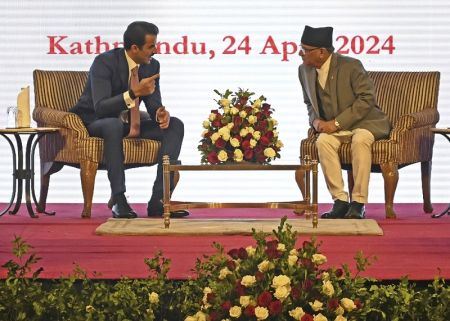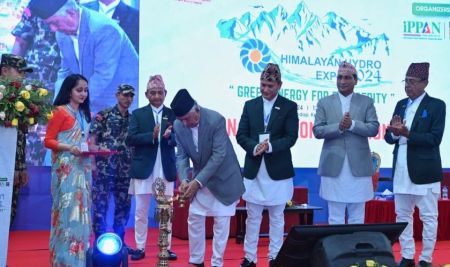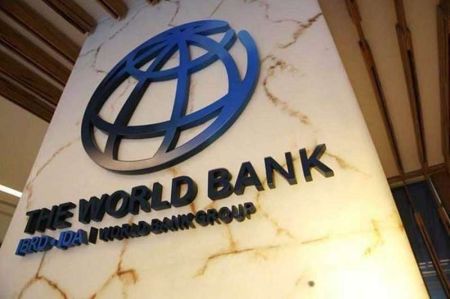.JPG)
--By Akhilesh Tripathi
If everything goes as planned by the government, Nepal will graduate from the Least Developed Country (LDC) status over the next eight years (i.e. by 2022) to a Developing Country (DC) status. Even if that target is not achieved by the specified time, the process that has been initiated already with the start of the current three-year plan (FY 2014 to FY 2016) has a lot in store for the private sector as opportunities, say analysts.
Foremost among such analysts is Dr Govind Raj Pokharel, Vice Chairman of National Planning Commission (NPC). He says, “Graduation from the LDC status is a Herculean task but it is achievable if the government and the private sector work together and there is strong support of the donor community. We have pinned a lot of hope on the private sector.”
Dr Pokharel claims that the next eight years over which Nepal will try its best to graduate from the LDC status to DC status will be full of business opportunities for the private sector. “We have expected a huge investment from the private sector. We know that the private sector will not invest without seeing opportunities first. Still, we hope that such investment will come from the private sector because there will indeed be opportunities,” he says.
.JPG) According to economists as well as the country’s graduation strategists, there will be business opportunities in all major sectors - agriculture, manufacturing, services, hydropower, tourism, infrastructure development etc. “These are the major areas where the private sector will find ample business opportunities provided that the government creates an enabling environment. But there will be opportunities in other sectors as well if there is an enabling environment,” shares Dr Hemanta Dawadi, Director General of the Federation of Nepalese Chambers of Commerce and Industry (FNCCI).
According to economists as well as the country’s graduation strategists, there will be business opportunities in all major sectors - agriculture, manufacturing, services, hydropower, tourism, infrastructure development etc. “These are the major areas where the private sector will find ample business opportunities provided that the government creates an enabling environment. But there will be opportunities in other sectors as well if there is an enabling environment,” shares Dr Hemanta Dawadi, Director General of the Federation of Nepalese Chambers of Commerce and Industry (FNCCI). It seems the government is keen about creating those opportunities for the private sector through change in policy in line with the development targets which will have to be achieved over the next eight years for Nepal to become a developing country. The good thing is this has started with the recently announced budget for the new fiscal year. “The budget is also poised to graduate Nepal from a Least Developed Country status as defined by the UN,” said Finance Minister Dr Ram Sharan Mahat while presenting the budget on July 13.
In his budget speech, Dr Mahat said that the country needs to invest minimum 30 percent of GDP in fixed capital formation to earn the identity of a developing country in the next eight years. “However, the average investment of past three years has been only 22 percent,” he noted, “To bridge this gap of eight percentage point in fixed capital formation, additional Rs 160.00 billion should be invested in the coming Fiscal Year alone.”
The Finance Minister proclaimed that various reform measures will be carried out in this fiscal year in order to increase domestic and external investment and facilitation. He said additional reforms and revisions will be carried out by evaluating the practices and experiences of policies, regulations and laws regarding industry, trade, energy, banking and financial sector that were started back in 1990's decade, adding that the next (14th) Periodic Plan will have a clear roadmap for transforming the country into developing country status within coming eight years.
To create the right opportunities for the private sector, the budget has also stated to amend the Companies Act, Competition Promotion and Market Protection Act and Insolvency Act. This will simplify the process of company establishment, renewal and liquidation. Similarly, the budget talks about amending the provisions of existing Debt and Guarantee Act in order to attract foreign investment in mega projects and viable sectors, where the domestic investment is insufficient.
“New laws regarding industrial enterprise and foreign investment and technology transfer will be formulated. Foreign Investment Policy and Industrial and Intellectual Property Policy will be formulated. Bill regarding Special Economic Zone will be tabled in Parliament. Procedures regarding the establishment of large industries under foreign investment will be simplified,” said the Finance Minister.
.jpg) Opportunities in Energy Sector
Opportunities in Energy Sector The government plans to end load-shedding over the next three years. In this period, four major public sector-funded projects namely Upper Tamakoshi, Kulekhani II, Chameliya and Upper Trishuli hydroelectric projects will enter production phase and will together generate 560 MW of electricity. Similarly, 42 private sector-funded hydroelectric projects will generate 628 MW of electricity in this period. Similarly, the government will start the construction of other projects such as Tamakoshi V, Madi Khola, Maiwa Khola hydroelectric projects including Tanahu and Rahughat projects. Similarly, according to the budget, the construction of Kabeli Hydroelectric Project will be started in Public-Private-Partnership model.
“The private sector will be invited to carry out various works related to these energy projects. That clearly means business opportunity,” explains Dr Arjun Karki, International Coordinator of LDC Watch, “Several other bigger projects will be initiated over the next eight years which means there will be good business opportunities for the private sector.”
In order to complete the projects on time, the budget has announced to provide full exemption on income tax for the first ten years and 50 percent exemption for additional five years to those producers who generate and connect electricity to national grid and export it within FY 2022/23. “I have made an arrangement to provide a lump sum grant of Rs 5 million per MW of electricity to those producers who generate and connect the generated electricity to national grid. I have also made provision of an additional 10 percent of such grant to those producers who generate and connect the generated electricity to national grid within FY 2017/18,” says Dr Mahat.
Opportunities in Agriculture
The government plans to modernise, diversify and commercialize the agriculture sector over the next one decade. This is reflected in the newly announced budget as well. The budget targets to keep interest rate on six percent on loans to be provided by the commercial banks for modern farming, livestock and poultry farming, medicinal plants, vegetables and horticulture, dairy business, aquaculture, agro storage, cold storage, slaughter house and meat-related business. This provision, the government thinks, will also help address the problem of unemployment and youth migration from rural areas.
Similarly, the budget has provisioned up to 50 percent subsidy in the loan interest taken in order to develop land and mechanize farming for private groups which are involved in the commercialization and mechanization of farming by integrating 10 hectares land in mountain and 20 hectares land in Terai and up to 75 percent interest grant for the cooperatives of marginalized and landless farmers.
Similarly, the construction of the main as well as branch canals of major irrigation projects such as Sikta, Babai, Mahakali and Rani Jamara Kulariya etc will be given continuity. It is the private sector that will be awarded contracts to carry out these works which clearly means good business opportunities for the private sector. Similarly, the tunnel construction work of Bheri Babai Multipurpose Diversion Project will also be initiated in this fiscal year.
“The government wants significant private sector investment in agriculture. For this it is ready to create the environment,” remarks Dr Pokharel.
.jpg) Opportunities in Tourism
Opportunities in Tourism Tourism is going to be another sector of good business opportunities for the private sector. The government, through the latest national budget, has already announced to provide income tax exemption for five years to the industries established with an investment of more than Rs 2 billion in the tourism sector. Similarly, aviation companies, too, will get such income tax exemption. They will further get 50 percent income tax exemption for subsequent three years, according to the budget.
“This income tax exemption is aimed at promoting the establishment of good hotels and resorts at the major tourist destinations and other places of the country. This is a clear opportunity for the private sector,” explains Dr Pokharel.
Opportunities in Infrastructure Development
Nepal has to do a lot in infrastructure development so as to increase accessibility, facilitate service delivery and enhance cost effectiveness. For example, the government wants to construct at least one road on multi-year contract basis in each electoral constituency where there is no year-round transportation. Similarly, the construction work of the Kathmandu-Terai Fast Track will be started in this fiscal year.
The government plans to open the track of several new roads, black-top and expand several existing roads and build hundreds of bridges across the country. The government has allocated more than Rs 14.3 billion for this purpose in the current fiscal year alone. Similarly, the new budget has allocated Rs 4.5 billion for the maintenance of 16,788 kilometres of strategic and local roads including their regular maintenance, routine maintenance, periodic maintenance, and rehabilitation and urgent maintenance.
Similarly, according to the new budget, the government will carry out urban infrastructure development programmes in cities like Biratnagar, Birgunj, Butwal, Dharan, Janakpur and Nepalgunj including the development of 10 Urban Corridors with eight ongoing and two new.
“The national budgets to be announced in the fiscal years to come will have to continue such infrastructure development programmes, if Nepal is to achieve the DC status by 2022. So, there is no dearth of business opportunities for the private sector,” says Dr Pokharel.
Investment Requirement
According to NPC’s estimates, the government or the public sector will have to invest Rs 3,300 billion and the private sector will have to invest double the amount – a whopping Rs 6,600 billion -by 2022 if Nepal is to achieve the status of a developing country by then. But will such a huge investment really come from the private sector?
“We hope it will because the country is now headed towards political stability and legal and economic reforms are in the pipeline. That means the next eight years are going to be a wonderful business opportunity for the private sector,” assures Dr Pokharel.
According to NPC’s investment plan, Nepal will need a total investment of Rs 1013.91 billion in the agriculture sector by FY 2021/22 to achieve the graduation target. Two-thirds of this investment, i.e. around Rs 675.94 billion is expected from the private sector. The agriculture sector includes forestry and fishing as its subsectors.
“The private sector is expected to invest in the modernization of agriculture and increase productivity, replace agricultural imports and promote exports. The government is expected to make this easier through policy and legal reforms, if necessary,” says Dr Pokharel.
Similarly, the industrial sector which includes mining and quarrying, manufacturing; electricity, gas and water, and construction will require a total investment of Rs 1807.87 billion. Of this amount, Rs 1205.24 is expected from the private sector. “So there is a huge opportunity for the private sector in the industrial sector as well,” thinks former NPC Vice Chairman Prithvi Raj Ligal.
Likewise, according to the NPC plan, the service sector which comprises wholesale and retail trade; hotels and restaurants; transport, storage and communications; financial intermediation; real estate, renting and business activities; public administration and defence; education; health and social work; and other community, social and personal service activities will require a total investment of Rs 6874.98 billion – Rs 4583.32 billion from the private sector and Rs 2291.66 billion from the public sector.
.jpg)
Criteria for Graduation
There are basically three criteria to graduate from the LDC status – Human Assets Index (HAI), Economic Vulnerability Index (EVI) and GNI per capita. HAI is about the stock of the human capital of the country and comprises the nutrition status of the population, mortality rate of children aged five or under, and gross secondary school enrolment ratio and adult literacy rate. EVI reflects the country’s vulnerability to exogenous shocks and comprises of population size; remoteness; merchandise export concentration; share of agriculture, forestry and fisheries in GDP; share of population living in low elevated coastal zones; instability in export of goods and services; victims of natural disasters; and instability in agricultural production.
Likewise, GNI per capita is related with the country’s income-generating capacity and is based on a three-year average estimate of the country’s per capita GNI (World Bank Atlas Method). After determining threshold level for each of the criteria every three years, the United Nations Committee for Development Policy (CDP) reviews the progress made by LDCs and if the country has been eligible at two successive triennial reviews, it recommends a country for graduation from the LDC category. At least two of the three criteria or GNI per capita twice higher than the threshold should be met in order to be eligible for graduation.
“Among the three criteria for LDC assessment, Nepal has already met the EVI threshold level and is very close to meeting the HAI criteria; however, there is a huge gap between the GNI threshold level and Nepal’s present status. The role of the private sector is going to be very important to meet this criterion,” observes Dr Karki.
Increasing Productive Capacity
Karki is of the opinion that Nepal will have to start working seriously to enhance its productive capacity significantly to achieve the GNI per capita threshold. “The country is facing problems like huge trade deficits, high underemployment rate, income inequality and low quality of life,” says Dr Karki, “Factors including subsistence agriculture, deteriorated industrial environment, power shortage etc., have led to a low level of economic growth and development. Therefore, there exists a great challenge to sustain the achievements and narrow down the gaps between GNI threshold level and the current status.”
Our GNI per capita has improved over the past few years but we still need to accelerate it, he adds. Karki’s observation points to two important areas where private sector can come forward – commercial agriculture and power generation. Fortunately, these are the two major areas of emphasis in the budget presented at the parliament recently. If the government really implements the policies and budget allocations announced in the budget speech, the privates sector can make good money while contributing to this graduation of the country.
Ligal lists more areas where the private sector has such opportunities. “Productive capacity has basically four components – infrastructure; energy; science, technology and innovation; and private sector development,” says Ligal, adding “The role of the private sector is very important in increasing the country’s productive capacity by investing in infrastructure development, energy exploitation and by making technological innovations.”
“Although Nepal has already met the EVI criterion, it still has to either increase its GNI per capita by US$ 770 or the HAI score by 6.17 before 2015 to be eligible for consideration for graduation. This is because eligibility conditions should be fulfilled during two successive triennial reviews, and the CDP will now review the progress only in 2015,” Chandan Sapkota, an economist with the Asian Development Bank, Nepal, says, “After the review, Nepal will have to sustain the progress through 2018, the next triennial review, only after which the CDP will recommend for graduation.”
This means Nepal has good length of time to fulfil the criteria. But effective intervention from the government is a must. And the NPC has recognised this clearly. “If the past trend is of any guide to future, it will be difficult for Nepal to meet the projected threshold of US$ 1,502 even by 2021, unless effective policy interventions are in place. Vigorous efforts are needed to achieve the projected GNI per capita of US $ 2,094 in 2021 so that the economy is on the way to achieve the estimated threshold by 2021,” reads NPC’s Approach Paper to Graduation from LDC by 2022.
According to Ligal, the private sector – both domestic and foreign – will have to invest heavily in sectors like physical infrastructure, hydropower, tourism and agriculture over the next eight years. “But the private sector will not make such a huge investment under the present circumstances. For private sector investment to come, the government will have to create conducive environment through legal, administrative and policy reforms. If this happens, private sector will come forward as the Graduation process would offer lucrative business opportunities,” he says, adding that Nepal needs more aggressive economic reforms in the near future.

Partnership with Private Sector
The Istanbul Programme of Action, which aims to at least halve the number of LDCsby 2020, too, has laid great emphasis on public-private partnership. It says, “Partnerships with the private sector play an important role for promoting entrepreneurship, generating employment and investment, increasing the revenue potential, developing new technologies and enabling high, sustained, inclusive and equitable economic growth in least developed countries.” In the present circumstances, when the private sector is complaining of lack of enough conducive environment for investment, PPP model can be a good alternative so that the private sector can feel secure as the government too will have stake in such projects.
Economists say that investment in the industrial sector is a must to increase the economic productivity. “Productivity and job opportunities in the service sector have remained low. And it consists of more informal sectors,” observes Shanker Sharma, former vice-chairman of NPC, “We need more manufacturing industries. If there is political stability, right policies in place and adequate legal reforms, then investment in the manufacturing sector will come.”
Karki, too, stresses on the need for public-private partnership (PPP) model of development. “The PPP model is going to be very helpful in those areas of investment where the private sector alone is a bit hesitant to enter,” he says. If the government comes forward to invest in such sectors, the private sector will follow suit, he adds.
Dr Dawadi is also of the opinion that the government alone cannot take the country out of the LDC status to the developing country status. “To be successful, the graduation strategy will require a full and uninterrupted understanding, support and cooperation from the private sector,” he opines.
True that both economists and development activists are right in their view that this target spelt out in the approach paper to the latest three-year plan (FY 2014 to FY 2016), is highly ambitious. But the government has its own basis for its optimism.
The doubt of the economists and activists is based on the fact that the previous three-year plan (FY 2010 to FY 2013) had aimed such graduation by 2030. But the government officials say they pre-poned the target by eight years looking at the rapid progress in the recent years. They particularly cite increase in the country’s per capita gross national income (GNI), decreased poverty level, and significant progress on major social indicators such as mortality rates, school enrolment rates, life expectancy etc. Since the LDC category was brought in practice in the international development parlance in 1970, only four LDCs have graduated to DC status so far – Botswana (1994), Cape Verde (2007), Maldives (2011) and Samoa (January 2014). But the number of LDCs has almost doubled since then. It means graduation from the LDC status is not so easy. But development experts think that the goal is achievable if the public and private sectors of the country work together.
When the economy grows and businesses thrive, the sky is the limit for the individual private sector operator. It means a large pool of resources, a larger market and a higher level of operation,” Dr Dabwdi concludes, “The opportunity will be for both new business creation as well as horizontal growth of existing businesses.”





















